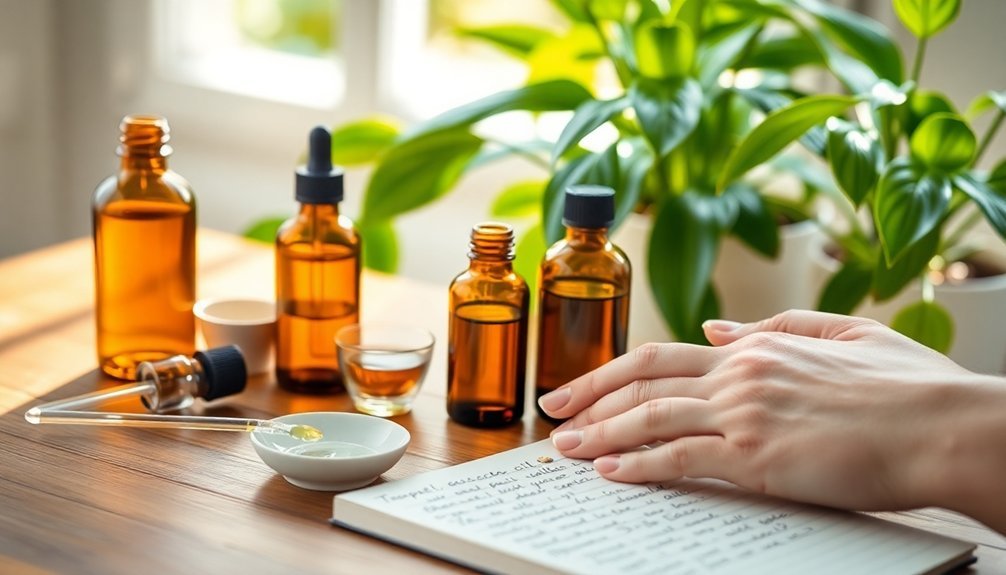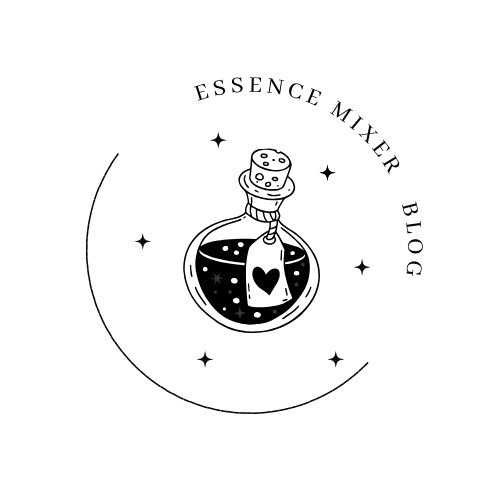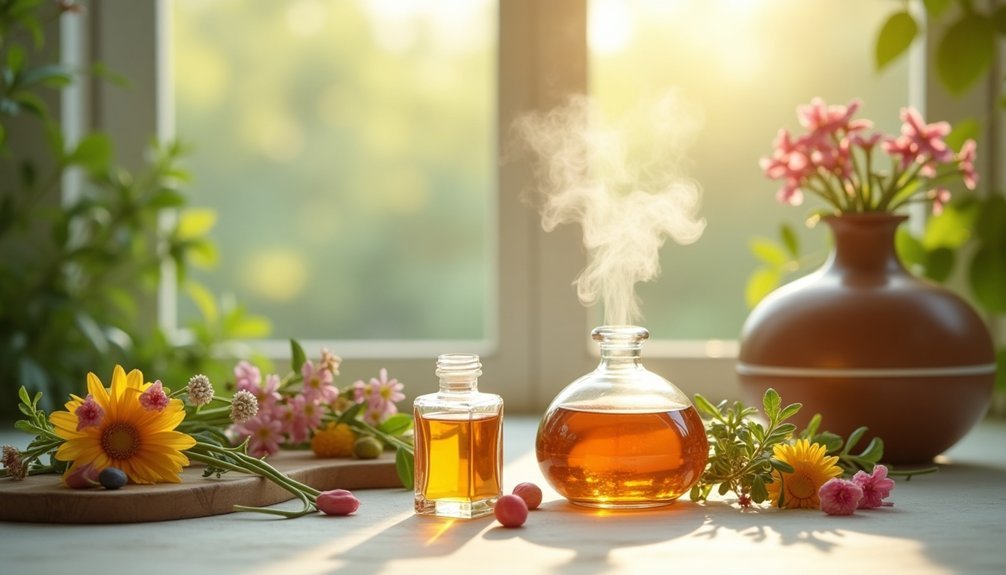To make safe aromatherapy perfumes, you'll need to follow three essential rules. First, always conduct patch tests on your skin with diluted oils to check for reactions before using them in blends. Second, source your essential oils from reputable suppliers who provide pure, properly labeled products with botanical names and origins. Third, stick to proper dilution ratios – typically 15% essential oils to 85% carrier oil. These fundamentals set the stage for creating beautiful, skin-safe fragrances.
Understanding Essential Oil Patch Testing and Skin Reactions

Before creating your own aromatherapy perfume, you'll need to guarantee your skin won't react negatively to the essential oils you've chosen. Essential oils can trigger skin irritation or allergic reactions, so conducting a patch test is vital for your safety.
To perform a patch test, dilute a small amount of essential oil according to recommended ratios (1% for sensitive skin). Apply this mixture to the inside of your elbow and cover it with a plaster for 24 hours.
After this time, check for any reactions like redness or itching to determine compatibility. Since skin sensitivities vary between different essential oils, you'll need to test each oil you plan to use in your perfume blend.
Never skip diluting oils before application, as using them undiluted greatly increases your risk of adverse reactions.
Selecting and Evaluating Quality Essential Oil Sources
How can you tell if an essential oil is truly worth your investment? Start by looking for bottles labeled as 100% pure, without synthetic additives or fillers.
You'll want to verify the botanical name, extraction method, and country of origin on each label to guarantee authenticity.
Choose essential oils from reputable suppliers who openly share their sourcing and testing practices. Quality suppliers will provide detailed information about their products and maintain transparency about their manufacturing processes.
Before making your purchase, research customer feedback and review third-party lab testing results to confirm the oils are safe to use.
Remember that high-quality essential oils will have distinct aroma profiles that can vary based on their geographical origin. This careful evaluation process helps guarantee you're getting authentic, pure oils for your aromatherapy perfumes.
Mastering Proper Dilution Ratios and Measurements

Once you've secured quality oils, mastering proper dilution becomes your next key focus.
When you make perfume, stick to the standard 15% essential oils to 85% carrier oil ratio for safe DIY perfume creation. For stronger fragrance oils, you can increase this up to 25%, but never exceed recommended dilution ratios for safety.
You'll need a precise scale to weigh your components in grams for accurate measurements. For a 10ml perfume, aim for 40 drops total: 20 drops of base note, 10 drops of middle note, and 10 drops of top note.
Remember that some essential oils require special attention – like cinnamon bark, which shouldn't exceed 0.07% dilution.
Always document your blending session details in a notebook to replicate successful formulations and maintain essential oil safety standards.
Frequently Asked Questions
What Is the 30/50/20 Rule for Perfume?
The 30/50/20 rule means you'll mix your perfume using 30% essential or fragrance oils, 50% alcohol, and 20% distilled water. It'll help you create a balanced, long-lasting scent that disperses well.
What Are the Three Components of Perfume?
You'll find three main components in perfume: top notes that give the initial impression, middle (heart) notes that form the core fragrance, and base notes that provide lasting depth to your scent.
What Are the Rules for Perfume?
You'll need to dilute essential oils properly (10-25%), always perform patch tests before use, and store your perfumes in dark glass bottles. These rules help guarantee safety and maintain your perfume's quality.
How Do You Make Aromatherapy Perfume?
You'll need to blend 40 drops of essential oils (20 base, 10 heart, 10 head notes), combine with 7ml alcohol in a 10ml atomizer, add distilled water, then let it age for 1-3 months.
In Summary
You've now learned the three fundamental rules for crafting safe aromatherapy perfumes: patch testing to prevent adverse skin reactions, sourcing high-quality essential oils from reputable suppliers, and measuring precise dilution ratios. Don't skip these vital safety steps when creating your signature scents. By following these guidelines, you'll protect your skin while enjoying the benefits of natural fragrances in your handmade perfumes.





Leave a Reply